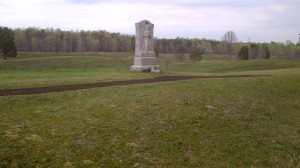The perception is that the withdrawal of the bulk of the artillery from General Johnson’;s line on the evening of May 11th was a unique event. However, this is not the case at all. All five of the artillery battalions spent some time along the lines of either Rodes or Johnson’s divisions. Generally speaking after two days they were replaced by another battalion. These reliefs were generally, although not always, made in the early morning hours.
However, this is not the case at all. All five of the artillery battalions spent some time along the lines of either Rodes or Johnson’s divisions. Generally speaking after two days they were replaced by another battalion. These reliefs were generally, although not always, made in the early morning hours.
But on the afternoon of May 10th Upton’s attack so threatened Nelson’s battalion,which held positions between the West and East Angles, that the guns were withdrawn during the action to prevent their capture. Even though Upton was repulsed the batteries went back to the camps behind the Courthouse for the night. The removal of these batteries from their positions while the infantry from Steuart’s and Jone’s Brigades were simultaneously being moved from the right of the Salient to positions near or along the McCoull Lane caused a lot of confusion and delay.
The following morning the batteries returned to their original positions.
One has to wonder whether the experience played a part in the decision to withdraw the two battalions out that afternoon before Johnson’s infantry moved.
